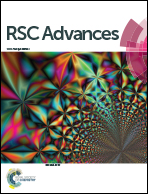Layer-by-layer assembled PMMA-SH/CdSe–Au nanocomposite thin films and the optical limiting property†
Abstract
PMMA-SH/CdSe–Au nanocomposite thin films have been constructed by a layer-by-layer (LBL) assembly method. The LBL assembly process is carried out in a nonpolar solvent by the combination of photopolymerization and adsorption of CdSe–Au nanoparticles. Absorption spectra suggest that the LBL assembly is performed in a stepwise and uniform way. The optical, morphological, thermal, and optical limiting properties of the resultant PMMA-SH/CdSe–Au nanocomposite thin films are characterized by transmission, TEM, TGA and laser measurements. The LBL assembled PMMA-SH/CdSe–Au nanocomposite thin films exhibit good thermal stability, transparency, and optical limiting response to a 532 nm pulsed laser. The optical limiting threshold of the PMMA-SH/CdSe–Au nanocomposite thin film is 13 J cm−2. This study provides a robust and efficient strategy for fabricating transparent polymeric thin films with laser optical limiting property.


 Please wait while we load your content...
Please wait while we load your content...